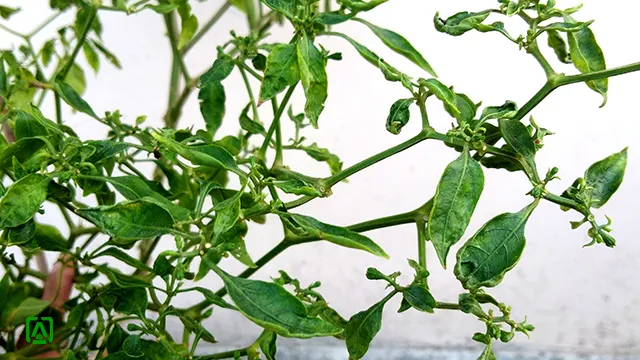leaf curl of chilli
Host: Capsicum annuum L. (Chilli)
Pathogen:Chilli leaf curl virus (ChiLCV)
Transmission of virus (Vector): Whitefly (Bemisia tabaci)
Pathogen:Chilli leaf curl virus (ChiLCV)
Transmission of virus (Vector): Whitefly (Bemisia tabaci)
Distribution
Leaf curl of chilli is distributed throughout the tropical and subtropical countries of the world, including Australia, Asia, Europe, Africa and America. The disease is of common occurrence in India, Pakistan, Bangladesh, Nigeria and USA (summarized by Thakur et al., 2018). In India, leaf curl of chilli is so destructive that it can cause 100 % loss in yield.
Symptoms
Leaf curl of chilli is marked by the typical symptoms of curl. Infected leaves show curling, upward rolling. Veins are swollen and thickened. Interveinous areas show blisters and yellowing. Petioles and internodes are shortened. Young leaves are greatly reduced in size and crowded. The infected plant is stunted. Young flower buds abscise before attaining maturity and anthers do not produce pollen grains.
 |
| Chilli plant infected with leaf curl virus (photograph was provided by Dr. Rani Mishra from her kitchen garden) |
Pathogen
The leaf curl of chilli is caused by chilli leaf curl virus (ChiLCV). ChiLCV belongs to the family geminiviridae. Its genome contains single-stranded circular DNA (ssDNA). ChiLCVs are transmitted through the whiteflies.
Control measures
As the disease is caused by a virus, preventive measures and IPM are best to practice.
- Healthy and uninfected seeds should be used
- On appearance of the symptoms, diseased plants should immediately be removed and burnt.
- To control the insect vectors, yellow sticky traps should be used.
- Use of silver colored (reflective) mulch is recommended.
- Use of trap crops attract more of the vectors to them.
- Resistant varieties developed by mass selection, back cross method and hybridization method should be used.
Sources
- Thakur, H., Jindal, S.K., Sharma, A. et al. Chilli leaf curl virus disease: a serious threat for chilli cultivation. J Plant Dis Prot 125, 239–249 (2018). https://doi.org/10.1007/s41348-018-0146-8
Wilt of chili
Host: Capsicum annuum L. (Chilli)
Pathogen: Fusarium oxysporum f.sp. capsici
Pathogen: Fusarium oxysporum f.sp. capsici
Distribution
Wilt of chilli distributed throughout the tropical countries. It was first reported in New Mexico by Leonian in 1919 (Leonian 1919). In India the disease is found wherever chilli is grown. Wilt disease a is serious threat to chilli production.
Symptoms
 |
| Chilli plant: wilted (left) and healthy (right) |
Initial symptom appears as yellowing of leaves (first older then younger). Thereafter, the leaves lose turgidity and shrivel. If not treated, stems also shrivel and the entire plant wilts. At this stage vascular tissues of infected plants show brown color. Fungal growth in the vascular tissues chokes the xylem vessel. It also secretes cell wall degrading enzymes and toxins. These are the reasons for the rapid wilting of the plants. The disease is more prevalent in dry weather and moist soil conditions.
Pathogen
Fusarium reproduces asexually by means of microcondia, macroconidia and chlamydospores. These asexual spores are disseminated by the air, water and through the equipment. Growth of the fungus is optimum at the temperature range between 25 – 28 °C. The pathogen is adapted for a long duration of survival in soil by means of chlamydospores.
Control measures
- As the wilt disease of chili is soil-borne, it can be effectively managed through the integration of cultural, biological and chemical control methods.
- Wilt disease can be prevented by sowing the plants on the ridges and by avoiding excessive irrigation.
- Hydrated lime is helpful in controlling the disease, because higher pH hinders the growth of pathogens.
- Solarization of soil before sowing reduces the pathogen population in the soil up to a depth of 15 cm.
- Trichoderma viride and Trichoderma harzianum are antagonists to the wilt pathogen. T. viride (2.0 kg) and farm yard manure (50 kg) is mixed and covered with polythene. When mycelial growth is visible, it should be applied in rows in an area of one acre.
- Bacillus subtilis and Pseudomonas fluorescens, induce the systemic resistance in chilli against wilt disease.
- Treatment of nursery soil with formalin or copper sulfate effectively controls the wilt pathogen.
- Seed treatment with fungicides such as, carbendazim 50 WP or captan 50 WP or thiram 75 DS @ 2.5 g/kg makes the seed disease free.
- Seedlings are also should be dipped in carbendazim 50 WP (0.1%) or benlate (0.05%) or captan (0.2%) for 30 minutes before transplanting.
- 1 % Bordeaux mixture should be applied in drench around the stem.
- In laboratory conditions, growth of fungus was effectively checked by the aqueous extracts of garlic and neem (Prasannath et al., 2011).
- Crop rotation should be practiced.
References
- Prasannath, K., Mahendran, S. and Karunakaran, S., 2011. Control of Fusarium wilt of chilli (Capsicum annuum L.) by crude plant extracts. Tenth Annual Research Session, Eastern University, Sri Lanka.
- Fusarium wilt of chilli pepper. Technical Bulletin No. 121. New Mexico Agricultural Experiment Station, Las Cruces, USA.
Anthracnose of chili
Pathogen: Colletotrichum capsici (Syd.) E.J. Butler & Bisby
Host: Chili (Caspicum sp.)
Host: Chili (Caspicum sp.)
Symptoms
 |
| Anthracnose of chilli |
Symptoms appear as small circular spots on the fruit, which gradually enlarge. In severely infected fruits more than two circular spots fuse to produce larger spots which later on cover the whole fruit area.




